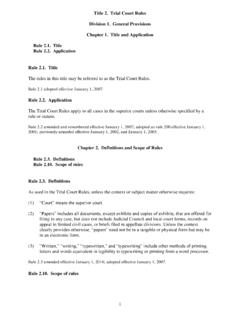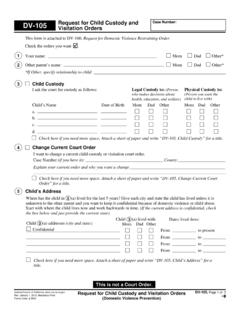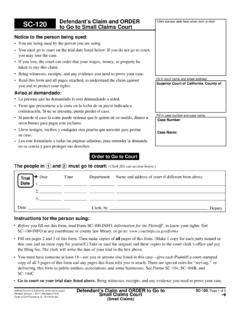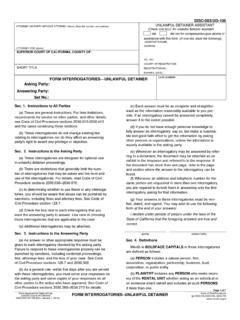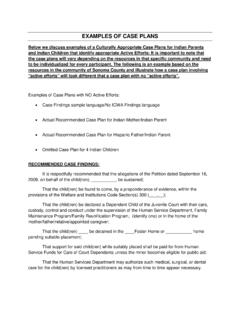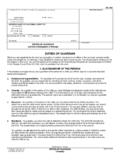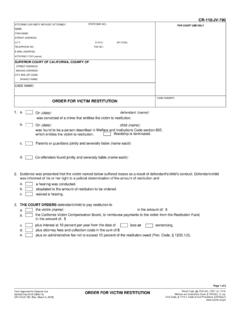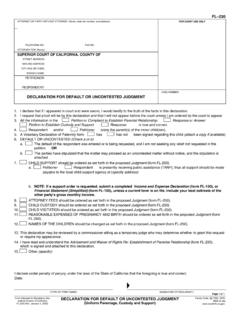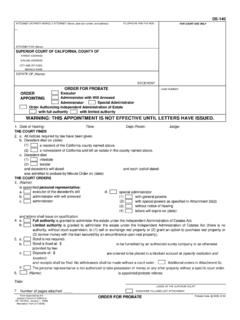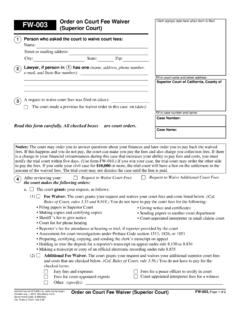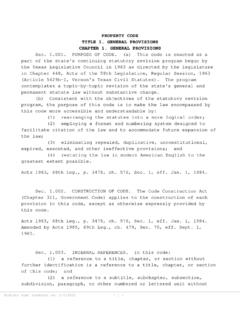Transcription of Rule 5.1 adopted effective January 1, 2007. Title 5 ...
1 Title 5. Family and Juvenile Rules Rule Title Rule Title The rules in this Title may be referred to as the Family and Juvenile Rules. Rule adopted effective January 1, 2007. Division 1. Family Rules Chapter 1. general provisions article 1. general provisions Title 5, Family and Juvenile Rules Division 1, Family Rules Chapter 1, general provisions article 1, general provisions ; adopted January 1, 2013. Rule Division Title ; definitions; application of rules and laws Rule Preemption; local rules and forms Rule Division Title ; definitions; application of rules and laws (a) Division Title The rules in this division may be referred to as the Family Rules.
2 (b) Definitions and use of terms As used in this division, unless the context or subject matter otherwise requires, the following definitions apply: (1) Family Code means that code enacted by chapter 162 of the Statutes of 1992 and any subsequent amendments to that code. (2) Action is also known as a lawsuit, a case, or a demand brought in a court of law to defend or enforce a right, prevent or remedy a harm, or punish a crime. It includes all the proceedings in which a party requests orders that are available in the lawsuit. 2 (3) Proceeding is a court hearing in an action under the Family Code, including a hearing that relates to the dissolution or nullity of a marriage or domestic partnership, legal separation, custody and support of minor children, a parent and child relationship, adoptions, local child support agency actions under the Family Code, contempt proceedings relating to family law or local child support agency matters, and any action filed under the Domestic Violence Prevention Act, Uniform Parentage Act, Uniform Child Custody Jurisdiction and Enforcement Act.
3 Indian Child Welfare Act, or Uniform Interstate Family Support Act. (4) Dissolution is the legal term used for divorce. Divorce commonly refers to a marriage that is legally ended. (5) Attorney means a member of the State Bar of California. Counsel means an attorney. (6) Party is a person appearing in an action. Parties include both self-represented persons and persons represented by an attorney of record. Any designation of a party encompasses the party s attorney of record, including party, petitioner, plaintiff, People of the State of California, applicant, defendant, respondent, other parent, other parent/party, protected person, and restrained person.
4 (7) Best interest of the child is described in Family Code section 3011. (8) Parenting time, visitation, and visitation (parenting time) refer to how parents share time with their children. (9) Property includes assets and obligations. (10) Local rule means every rule, regulation, order, policy, form, or standard of general application adopted by a court to govern practice and procedure in that court. (11) Reschedule the hearing means the same as continue the hearing under the Family Code and refers to moving a hearing to another date and time.
5 (Subd (b) amended effective July 1, 2020.) 3 (c) Application of rules The rules in this division apply to every action and proceeding to which the Family Code applies and, unless these rules elsewhere explicitly make them applicable, do not apply to any other action or proceeding that is not found in the Family Code. (d) general law applicable Except as otherwise provided in these rules, all provisions of law applicable to civil actions generally apply to a proceeding under the Family Code if they would otherwise apply to such proceeding without reference to this rule.
6 To the extent that these rules conflict with provisions in other statutes or rules, these rules prevail. (e) Law applicable to other proceedings In any action under the Family Code that is not considered a proceeding as defined in (b), all provisions of law applicable to civil actions generally apply. Such an action must be commenced by filing an appropriate petition, and the respondent must file an appropriate response within 30 days after service of the summons and a copy of the petition. (f) Extensions of time The time within which any act is permitted or required to be done by a party under these rules may be extended by the court upon such terms as may be just.
7 (g) Implied procedures In the exercise of the court s jurisdiction under the Family Code, if the course of proceeding is not specifically indicated by statute or these rules, any suitable process or mode of proceeding may be adopted by the court that is consistent with the spirit of the Family Code and these rules. Rule amended effective July 1, 2020; adopted effective January 1, 2013. Rule Preemption; local rules and forms Each local court may adopt local rules and forms regarding family law actions and proceedings that are not in conflict with or inconsistent with California law or the California Rules of Court.
8 effective January 1, 2013, local court rules and forms must comply with the Family Rules. Rule adopted effective January 1, 2013. 4 Advisory Committee Comment The Family and Juvenile Law Advisory Committee agrees with the Elkins Family Law Task Force: Final Report and Recommendations (final report) regarding local rules of court (see final report at pages 31 32). The final report is available at The advisory committee encourages local courts to continue piloting innovative family law programs and practices using local rules that are consistent with California law and the California Rules of Court.
9 Courts must not adopt local rules that create barriers for self-represented litigants or parties represented by counsel in getting their day in court. Further, courts should not adopt general rules for a courtroom as they pose substantial barriers to a party s access to justice. article 2: Use of Forms Title 5, Family and Juvenile Rules Division 1, Family Rules Chapter 1, general provisions article 2, Use of Forms; adopted January 1, 2013. Rule Use of forms Rule Use of forms (a) Status of family law and domestic violence forms All forms adopted or approved by the Judicial Council for use in any proceeding under the Family Code, including any form in the FL, ADOPT, DV, and EJ series, are adopted as rules of court under the authority of Family Code section 211; article VI, section 6 of the California Constitution; and other applicable law.
10 (b) Forms in nonfamily law proceedings The forms specified by this division may be used, at the option of the party, in any proceeding involving a financial obligation growing out of the relationship of parent and child or husband and wife or domestic partners, to the extent they are appropriate to that proceeding. (c) Interstate forms Notwithstanding any other provision of these rules, all Uniform Interstate Family Support Act forms approved by either the National Conference of Commissioners 5 on Uniform State Laws or the Department of Health and Human Services are adopted for use in family law and other support actions in California.
